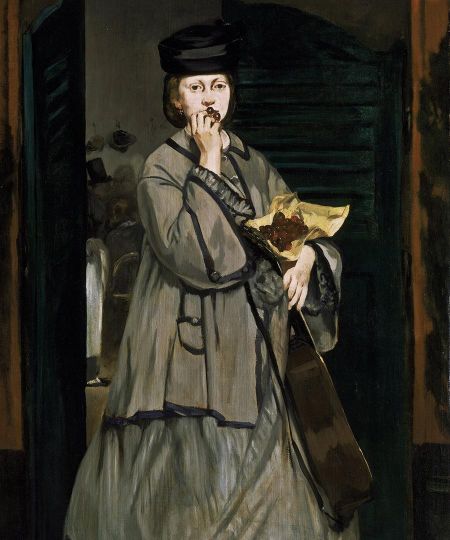Love the works of Edouard Manet but can’t get or move to London before the Royal Academy of Arts show on the artist’s portraits closes on April 14? Opening today in movie theaters worldwide is MANET, a “cinema event” showcasing the exhibit, from Phil Grabsky, Seventh Art Productions, NCM Fathom Events and BY Experience. BY Experience is the company that’s pioneered the filming of live events for movie audiences; it’s best known for showing performances from New York City’s Metropolitan Opera and London’s National Theatre. Still, operas and plays, which possess narrative and action, are naturals for the big screen—but how could an art exhibit be presented, and would it be compelling?
 MANET, the first in a planned series (Munch and Vermeer are scheduled for June 27 and October 10, respectively) is a strange hybrid of documentary and lecture. The audience’s guide is Tim Marlow, a British art historian and TV broadcaster, and he’s both appealing and knowledgeable without being pedantic. The movie provides a few tantalizing behind-the-scenes glimpses of the process involved in staging a major show—requesting the works from other museums, deciding their order and what the galleries should look like, packing and unpacking them very carefully—but more would have been welcome.
MANET, the first in a planned series (Munch and Vermeer are scheduled for June 27 and October 10, respectively) is a strange hybrid of documentary and lecture. The audience’s guide is Tim Marlow, a British art historian and TV broadcaster, and he’s both appealing and knowledgeable without being pedantic. The movie provides a few tantalizing behind-the-scenes glimpses of the process involved in staging a major show—requesting the works from other museums, deciding their order and what the galleries should look like, packing and unpacking them very carefully—but more would have been welcome.
The bulk of the film consists of Marlow telling us about Parisian society and Manet’s life story—the big scandal was his marrying his piano teacher, who may also have had an affair with Edouard’s father—and interspersing it with focusing on a painting from the exhibit and discussing it with an expert. The experts range from the show’s two co-curators, one from the Royal Academy and one from the Toledo Museum of Art in Ohio (side note: why did producers let the American confirm every European’s bad impression of us by allowing him to wear an “I HEART Manet” button?) to academics and actress/director Fiona Shaw.
 At those moments, the film resembles a condensed college art history lecture—and not in a bad way. You gain some insights into the cultural milieu of 19th-century Paris and Manet’s influence on the art world. But unfortunately, only a fraction of the 50-some works in the show get this treatment, leaving you to wonder about the rest of the paintings and drawings and preventing you from feeling like you were truly there. And that points to the core weakness of MANET. The reason why people endure long lines or travel distances to see such a show is to have the rare opportunity to see a large group of an artist’s works all at once, compare them, and track his development over time. MANET can’t convey that sense of overview and evolution, and even though it’s filmed in crisp HD, it can’t capture the awe-inspiring brushwork and layering of color employed by masters like Manet.
At those moments, the film resembles a condensed college art history lecture—and not in a bad way. You gain some insights into the cultural milieu of 19th-century Paris and Manet’s influence on the art world. But unfortunately, only a fraction of the 50-some works in the show get this treatment, leaving you to wonder about the rest of the paintings and drawings and preventing you from feeling like you were truly there. And that points to the core weakness of MANET. The reason why people endure long lines or travel distances to see such a show is to have the rare opportunity to see a large group of an artist’s works all at once, compare them, and track his development over time. MANET can’t convey that sense of overview and evolution, and even though it’s filmed in crisp HD, it can’t capture the awe-inspiring brushwork and layering of color employed by masters like Manet.
I applaud this film’s makers for creating a way to let people all over the globe view art exhibits and making it accessible, and I look forward to watching how their efforts change and improve, as they surely will. But while MANET succeeds in engaging the mind, it doesn’t stir the soul, which is what great art is able to do.
Click here to see where MANET is showing near you.









































